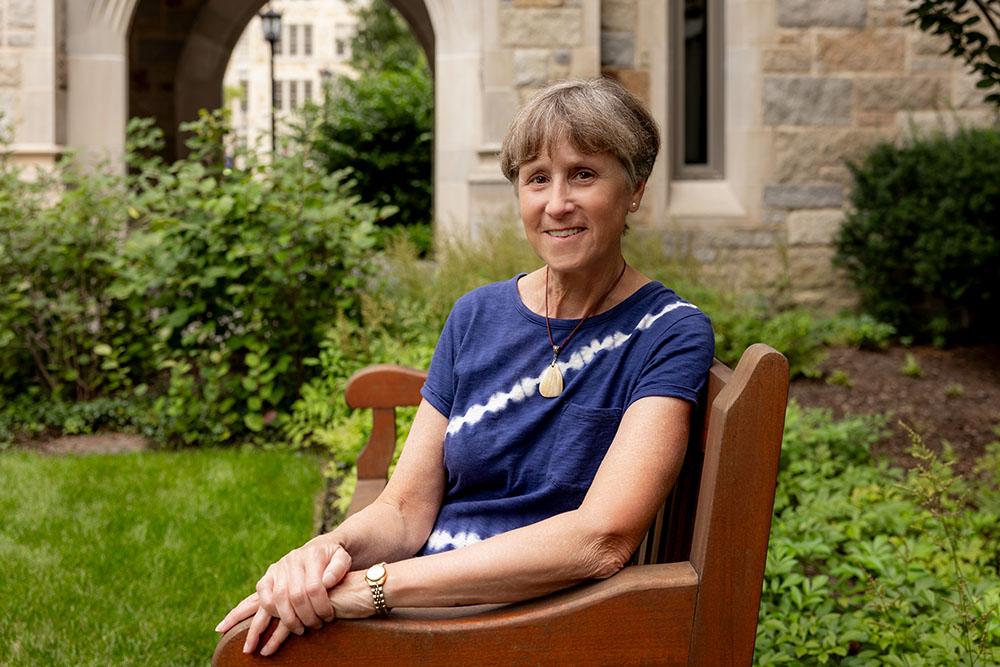
A taste of history
In 1894, a person walking down Hanover Street in Boston’s North End might have taken note of the city’s only Jewish restaurant, located down the street from a local synagogue. But by 1920, a Jewish eatery or grocery store was a common site, with more than 300 establishments offering delicacies like borscht, potato knishes, and bagels and lox.
This rapid growth coincided with an influx in migration from Russia and Eastern Europe in the late 19th and early 20th centuries, which resulted in a growing orthodox community in Boston and increased demand for kosher foods. Immigrants from other parts of the world were opening restaurants as well, eventually outnumbering native-born owners and transforming Boston’s food scene into a multicultural hot spot where diners could sample cuisine from around the world without venturing beyond city limits.

Marilynn Johnson. Photo by Caitlin Cunningham.
“The top group were Russian immigrants followed closely by Greek immigrants who were a fairly small group in the city and yet they owned a huge number of restaurants,” said Boston College Professor of History Marilynn Johnson, who specializes in urban and immigration history. “A lot of them served Greek dishes but you could also get hamburgers—they were trying to provide something for everyone.”
This summer, Johnson launched a new digital project showcasing several years’ worth of research into the fascinating history of immigrant-owned restaurants in Boston. Titled “Global Eats,” the website contains interactive maps showing the names and locations of ethnic eateries in 1895 and 1926, as well as a chart showing the shifting ethnic makeup of the city’s restaurant owners between 1909 and 1937.
In addition to numerical data, Global Eats also features carefully researched pages chronicling the establishment, growth, and public perception of six ethnic restaurant categories in Boston—German, Italian, Chinese, Jewish, Greek, and Syrian—during the early 20th century. Interesting facts abound: Boston’s first Italian restaurant, Vercilli’s, served mainly French and American food, a trend among Italian restaurants until the 1890s, when southern Italian immigrants flooded the city; and “Greenie,” one of the city’s earliest Jewish grocery stores, grew to become the modern-day Stop & Shop.
“ It’s great to be able to put this history to use and make it visible for people. ”
To gather data for the project, Johnson and a team of 30 students enrolled in her Street Life: Urban Space and Popular Culture course combed through city directories and the Boston Licensing Board records, compiling a list of restaurant owners for each year and then matching them with census and immigration records to determine their nativity. After the course concluded, one of Johnson’s students stayed on as a research assistant to continue the search, going through city tax records to determine the ownership of restaurants the class had missed.
Despite her expertise in Boston’s immigration history (her book, The New Bostonians: How Immigrants Have Transformed the Metro Area Since the 1960s, was published in 2015), Johnson found some of the data surprising. Going into the project, she expected to see the names of Irish immigrants well represented among local restaurant owners, but they barely registered.
“It turns out they were not big in the food business,” she said. “They owned a lot of taverns and saloons but they don’t show up in the restaurant business until those older pubs started turning into family restaurants in the 1930s and 40s.”

Unidentified man seated at the Oriental Restaurant at 32 Harrison Street owned by Bun Fong Low Company, ca. 1895-1910. Courtesy of the Trustees of Boston Public Library.
Global Eats is the latest addition to Johnson’s larger project: Global Boston, a digital collection of research and resources related to immigration in Greater Boston. Originally launched in 2016 as a companion to The New Bostonians, Johnson has been partnering with students and faculty to add original content to the site ever since. Lately, she’s been adding pages to the site’s section on immigrant neighborhoods to include nearby cities and suburbs like Cambridge, Lynn, and Chelsea, all of which have rich immigrant histories.
Some of the most intriguing projects have come about by happenstance. When a student mentioned she was from Maynard, Mass., a former mill town located 20 miles west of Boston, Johnson suggested she write a page on it. To her surprise, the student discovered that the town had once been home to a large and thriving Finnish community, which had established saunas, food co-ops, and other institutions. A Finnish-American society still exists in the area today.
“It’s a lot of fun and you never know what you’re going to discover,” Johnson said. “It’s great to be able to put this history to use and make it visible for people.”
